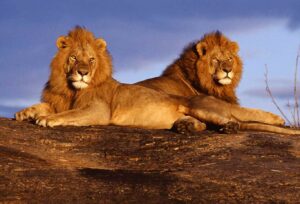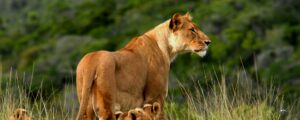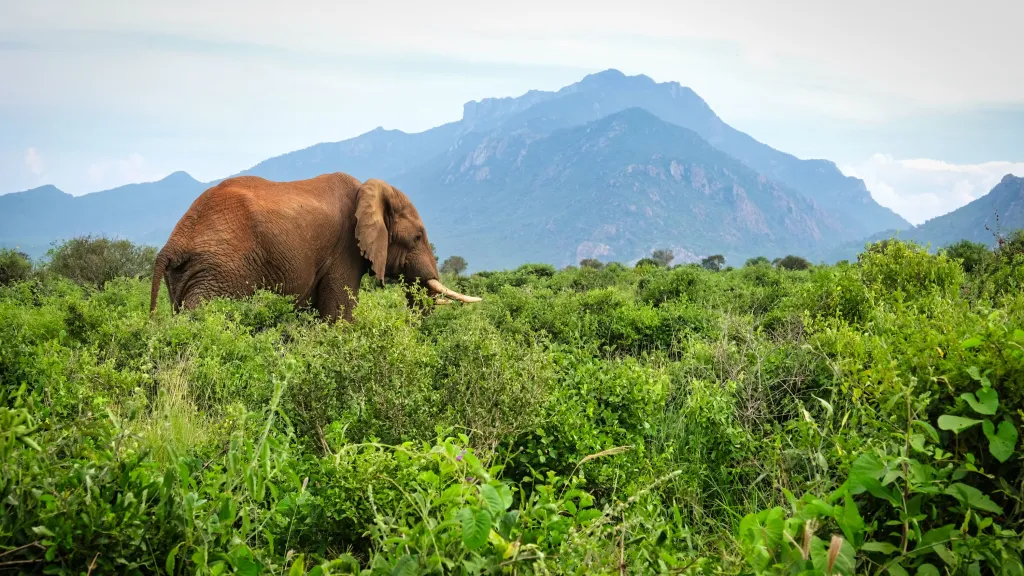Of all of Kenya’s magnificent national parks, none carries a name quite as evocative or as fitting as Tsavo’s moniker: the “Land of Giants.” This is not merely a marketing slogan; it is a profound truth etched into the very soil, history, and wildlife of this vast, untamed wilderness. Tsavo is a place of scale and legend, where the elephants are dusted in crimson, the lions are woven into folklore, and the landscapes stretch to the horizon with a raw, primal power. Encompassing a staggering 22,000 square kilometers, Tsavo is not just a park; it is an experience that redefines one’s understanding of the wild. This is Kenya at its most ancient and elemental, a must-visit destination for those seeking to venture beyond the well-trodden safari path and into the heart of a true African giant. Book trip to Tsavo
The Meaning Behind “Land of Giants”
The title “Land of Giants” is a multifaceted tribute to Tsavo’s most defining characteristics. Most visibly, it refers to its famous red elephants. The region’s fine, iron-rich red soil acts as a constant cosmetic, as the world’s largest land mammals dust-bathe and spray themselves, transforming their typically grey hides into a magnificent, deep ochre. Against a backdrop of green acacia bushes and golden grass, these crimson giants are a breathtaking and uniquely Tsavo sight.
The name also echoes with the deep, rumbling growl of historical legend. The “Man-Eaters of Tsavo,” a pair of notorious lions that halted the construction of the Kenya-Uganda Railway in 1898 by preying on railway workers, forged a reputation of fearsome grandeur that the park’s lions still carry today. Their story, though a grim chapter, cemented Tsavo’s identity as a place where nature reigns supreme and untamed.
Finally, the “giant” designation is literal. Tsavo is Kenya’s largest national park, a colossal protected area that is larger than some countries. This immense size creates a sense of boundless space and isolation, making every safari encounter feel like a personal discovery in a truly giant wilderness.Book trip to Tsavo
Tsavo’s Immense Size and Geography
Tsavo is divided into two distinct halves by the Nairobi-Mombasa highway and railway line: Tsavo East and Tsavo West. Though part of the same ecosystem, they offer dramatically different experiences.
-
Tsavo East: The larger of the two, this park is characterized by flat, dry, open savannahs, scattered scrubland, and the immense Yatta Plateau, the world’s longest lava flow. The Galana River snakes through this arid landscape, providing a vital lifeline for wildlife. The feeling here is one of immense, sun-baked expanse.
-
Tsavo West: is greener and more rugged, featuring dramatic volcanic landscapes like the Chyulu Hills (recently designated a UNESCO World Heritage Site) and the stark, black Shetani Lava Flows. Its most famous feature is Mzima Springs, an oasis of crystal-clear water that gushes from underground aquifers, supporting a rich concentration of hippos, crocodiles, and birdlife. Book trip to Tsavo
The Red Elephants of Tsavo
The image of a Tsavo red elephant is an iconic symbol of Kenyan wildlife. The phenomenon is simple yet stunning: the elephants regularly spray themselves with water and then with the fine red volcanic dust, which acts as a natural sunscreen and insect repellent. The result is a magnificent, deep red coating that makes them appear as moving sculptures of the earth itself.
Tsavo is home to the largest single elephant population in Kenya, a testament to its size and the success of conservation efforts following the poaching crises of the past. Watching a massive herd of these red giants moving slowly across the plains, their hides glowing in the afternoon sun, is a sight that defines the Tsavo experience and underscores its critical role as a sanctuary for Africa’s most beloved giants. Book trip to Tsavo
The Legendary Man-Eaters of Tsavo
The park’s history is forever intertwined with the story of two lions who, over a nine-month period in 1898, terrorized the camp of Indian railway workers constructing a bridge over the Tsavo River. Their unprecedented boldness and cunning—often pulling men directly from their tents—halted construction and spawned a legend.
The lions were eventually shot by Lieutenant-Colonel John Henry Patterson, who later wrote the famous book, The Man-Eaters of Tsavo. Their story has been the subject of multiple films and continues to fascinate. Today, the two lions are stuffed and on display at the Field Museum in Chicago, but their legacy lives on. Visitors can learn more about this chapter of history at the Tsavo Railway Museum and stand on the very bridge where the events unfolded, adding a layer of thrilling historical intrigue to any safari. Book trip to Tsavo
Wildlife Diversity in Tsavo
Beyond its famous elephants and legendary lions, Tsavo is a stronghold for the Big Five. While rhinos are elusive and best seen in the heavily protected Ngulia Rhino Sanctuary in Tsavo West, the parks support healthy populations of lions, leopards, Cape buffalo, and of course, elephants.
Other “giants” abound: towering giraffes nibble on acacia tops, hippos and massive Nile crocodiles thrive in the rivers and springs, and the skies are home to some of Africa’s largest birds, like the kori bustard. In total, over 500 species of birds have been recorded, from the vibrant carmine bee-eater to numerous birds of prey, making it a paradise for birdwatchers.
Tsavo East Highlights
-
Lugard Falls: Not a waterfall in the traditional sense, but a series of spectacular, powerful rapids carving through black rock. It’s a fantastic spot for photography and to see crocodiles basking on the rocks.
-
Aruba Dam: Built on the Voi River, this man-made reservoir is a magnet for wildlife, especially during the dry season. It’s one of the best places in Tsavo East to reliably see large concentrations of animals, including elephants, zebras, and predators coming to drink.
-
The Open Plains: The vast, flat landscapes of Tsavo East provide unparalleled visibility, making it easier to spot herds of elephants, lions resting under a distant tree, and the park’s many antelope species.Book trip to Tsavo
Tsavo West Highlights
-
Mzima Springs: The jewel of Tsavo West. An underwater observation tank allows you to watch hippos glide gracefully underwater and see schools of fish as if in an aquarium, a truly unique safari experience.
-
Shetani Lava Flows: A stark, black expanse of solidified lava from relatively recent volcanic activity (several hundred years ago). Walking across this otherworldly landscape feels like stepping onto another planet.
-
Ngulia Rhino Sanctuary: A heavily fenced and guarded sanctuary within the park dedicated to protecting the highly endangered black rhino from poaching. While sightings are not guaranteed, a visit supports vital conservation work and offers a chance to see these prehistoric-looking giants.
Unique Safari Experiences in Tsavo
Beyond classic game drives, Tsavo offers unique ways to connect with the wilderness. Walking safaris are available in designated private conservancies and around certain lodges, offering an intimate, ground-level perspective on the ecosystem. The incredible geological formations and birdlife also make it a premier destination for photography adventures focused on landscapes and macro-details often missed from a vehicle. Book trip to Tsavo
Best Time to Visit Tsavo
The dry seasons (June-October and January-February) are the best for general game viewing. With vegetation sparse and animals congregating around permanent water sources, wildlife is easier to spot. The wet seasons (March-May and November-December) transform the park into a lush, green paradise. While animals may be more dispersed, this is the best time for birdwatching, photography of dramatic skies, and enjoying the parks with fewer visitors. Book trip to Tsavo
Accessibility and Travel Logistics
Tsavo’s location halfway between Nairobi and Mombasa makes it incredibly accessible and a perfect addition to any Kenyan itinerary. It can be easily reached by road on the modern Nairobi-Mombasa highway. Numerous airstrips also serve both parks for those preferring to fly. Tsavo is most commonly combined with a safari in Amboseli or a beach holiday on the Kenyan coast. Book trip to Tsavo
Accommodation in Tsavo
The parks offer a wide range of accommodation. Luxury lodges perch on hillsides with sweeping views of the savannah and waterholes. Mid-range tented camps offer an authentic bush experience with comfort. For the more adventurous, budget-friendly campsites provide a true back-to-nature experience under the vast African sky. Book trip to Tsavo
Conservation Efforts in Tsavo
Tsavo is at the forefront of Kenya’s conservation efforts. The Kenya Wildlife Service (KWS) works tirelessly on anti-poaching patrols, particularly to protect elephants and rhinos. Community-based initiatives are crucial, involving local communities in conservation and tourism, ensuring they benefit from protecting the wildlife on their doorstep. Visiting Tsavo directly contributes to these vital efforts. Book trip to Tsavo
Cultural Connections Around Tsavo
The lands surrounding Tsavo are home to the Taita, Kamba, and Maasai people. Many lodges offer opportunities for cultural visits to local villages, where you can learn about traditional ways of life, crafts, and storytelling traditions that are deeply connected to the land and its history, including the legends of the Man-Eaters.
Tsavo Compared to Other Kenyan Parks
Tsavo offers a different experience from parks like the Masai Mara or Amboseli. It is larger, wilder, and less crowded. While wildlife densities can be lower and more spread out, the reward is a sense of having a piece of the wilderness all to yourself. It’s the perfect destination for travelers who have already experienced the classic safari and are seeking a more rugged, exploratory, and off-the-beaten-path adventure. Book trip to Tsavo
Photography Opportunities

Tsavo is a photographer’s dream. The red elephants provide a unique subject against green and gold landscapes. The black lava flows and giant baobab trees create dramatic and stark backdrops. The golden light of early morning and late afternoon, known as the golden hour, paints the entire scene in a magical glow, perfect for capturing the essence of the Land of Giants.
Family-Friendly Safari in Tsavo
Many lodges in Tsavo are well-suited for families, offering swimming pools, family rooms, and educational programs about elephants and conservation. The dramatic history of the Man-Eaters and the otherworldly landscapes of Mzima Springs and Shetani Lava Flows are particularly captivating for older children and teenagers. Book trip to Tsavo
Frequently Asked Questions (FAQs)
-
Why are Tsavo elephants red? They dust-bathe in the park’s fine, iron-rich red volcanic soil, which acts as a natural sunscreen and insect repellent.
-
What makes Tsavo the “Land of Giants”? The name refers to its red elephant giants, the legendary man-eating lions, and the park’s immense physical size.
-
Can I see the Big Five? Yes, though black rhino are very rare and best seen in the protected Ngulia Rhino Sanctuary in Tsavo West.
-
Which is better: East or West? Tsavo East is flatter and drier, better for elephant sightings and open plains. Tsavo West is greener and more volcanic, offering Mzima Springs and rhino tracking. Most visitors benefit from seeing both.
-
How far is Tsavo from Nairobi/Mombasa? It is approximately a 4-5 hour drive from either city, located almost perfectly between them. Book trip to Tsavo
Conclusion
Tsavo National Park earns its name with a powerful and unforgettable presence. It is a land shaped by fire and water, history and legend. It is where you come to witness the profound spectacle of red elephants marching through the dust, to feel the thrill of standing on a volcanic flow, and to listen for the echoes of legends in the rustling grass. More than just a safari destination, Tsavo is an immersion into the very soul of wild Kenya—a true Land of Giants. Book trip to Tsavo

Ready to explore the vast, red-dusted wilderness of Tsavo and witness its legendary giants for yourself? Woodsy Adventures offers expertly guided safaris into the heart of both Tsavo East and Tsavo West National Parks. We’ll take you to the iconic landmarks, help you track wildlife, and share the incredible stories that make this park so unique. Contact us today to book your Tsavo adventure and experience the awe-inspiring scale of Kenya’s largest park. Book trip to Tsavo

 Book trip to Tsavo
Book trip to Tsavo


